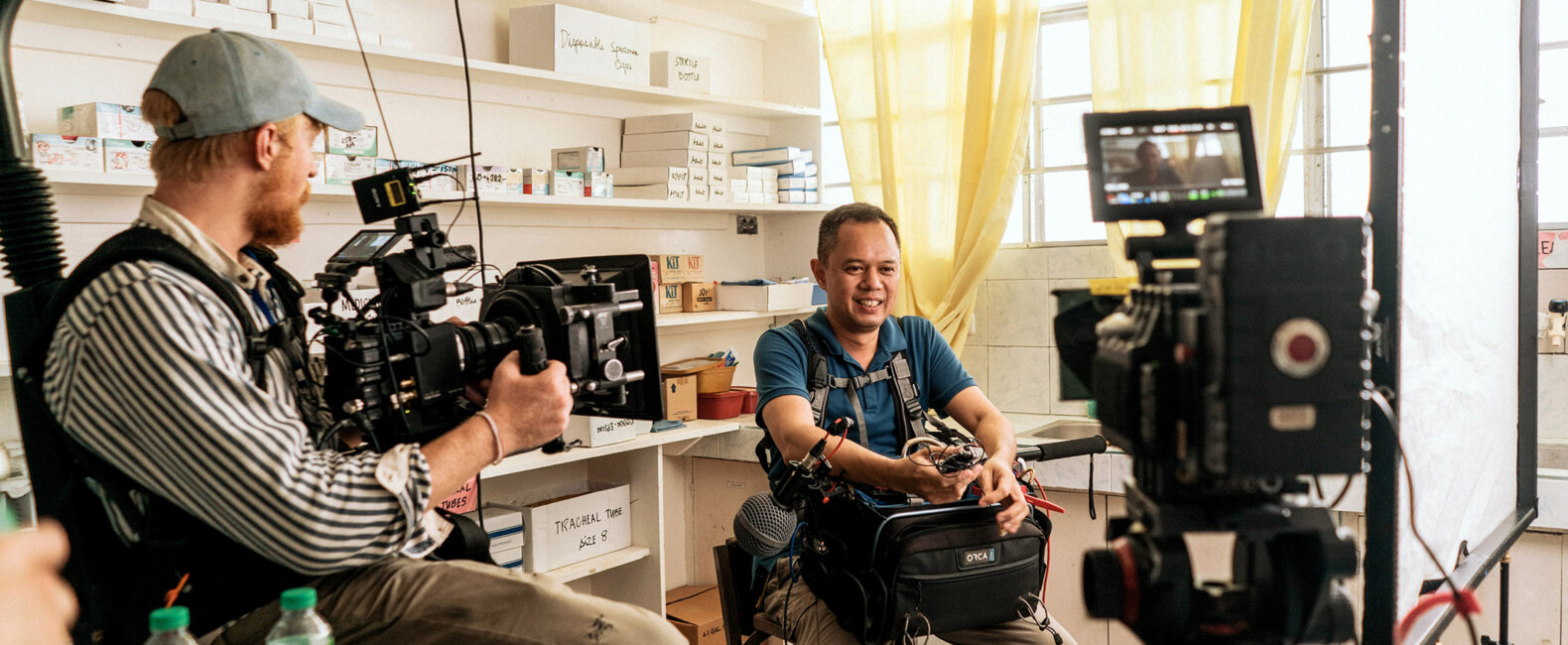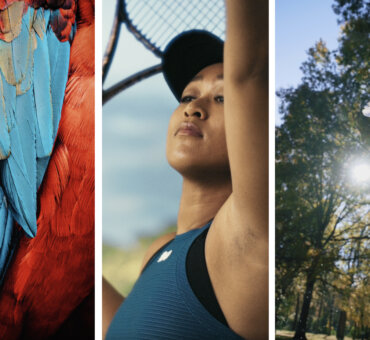Producing a nonprofit film can be difficult because the work is so important. There’s a looming social/humanitarian/environmental problem and taking a chance on a film production isn’t always in the cards. Also, words like “capital” and “budget” tend to complicate the matter, too.
“It’s very difficult to convince a nonprofit to take away monetary resources from actual clinics and move that into marketing,” Director Cole Sax told us. “Very few nonprofits are comfortable with doing that.”
So, how do you convince non-profits to spend their hard-earned dollars on a production when that money could go directly to their efforts? Cole pointed out that the reluctance to move those dollars to marketing represents a mindset problem: A non-profit film isn’t a distraction from the effort; it is part of the effort.
Cole is the winner of our 2017 Musicbed Film Initiative Grant, which he used to pull off his stunning short documentary Second Sight about a Filipino family facing blindness and redemption head-on. But, it wasn’t exactly easy getting this project off the ground, even with a grant to jumpstart things. It took some strategic thinking to get more funding.
During the planning phase, Cole and his team came across this incredible TED Talk from Dan Pallotta about how the nonprofit sector is a broken industry and they were inspired to find new ways to make the film achievable. They developed some key points on:
- Choosing the right subject
- Creating for your audience
- Casting for your film
- Pitching to potential fundraisers
- Using grants to your advantage
So, if you’re a filmmaker thinking about producing a nonprofit film, Cole has a few insights as to how he pulled off Second Sight. But first, we’re proud to present the debut of the film. It’s a seed that started with Musicbed Initiative and we couldn’t be more proud to say we were a part of it.
Are You Passionate About Your Subject?
Let’s not jump the gun, here. It’s fine if you want to help people with your craft, but are you even choosing the right subject? Producing a nonprofit film is a long, arduous process. So, first things first, you need to be passionate about your subject.
Cole told us that he first heard about cataract blindness in developing regions when he was just 14 years old and the idea stuck in his head as he became older. The image of a person being cured of their blindness after surgery was a powerful visual image, one he couldn’t get out of his head. He remembered a family friend who performed the surgeries:
“I would hear stories of him curing the blind, wilted people blooming like flowers,” Cole said. “People were jumping and dancing and singing. That emotion, it’s just something special to watch. We all felt it was an important story worth sharing.”
There’s more than just his passion for the subject, too. Notice how Cole described that moment? It’s a powerful visual representation of a nonprofit’s work for a visual medium—filmmaking.
So, ask yourself if your subject is well represented in a film format. These productions take a lot of time, money, and effort, so you’ll want a subject that speaks visually, audibly, and viscerally to your audience.

How Will Your Audience Empathize?
This point it so important—and very clever on Cole’s part. When you’re developing your concept, think about the people you want to connect with. Chances are, they aren’t going to have the same problems as the people they’ll be donating too.
Of course, there’s always sympathy. It’s the whole reason people are willing to donate. But, if you can help your audience connect with empathy and make them feel the conflict and struggle, then you’re developing a concept that will work.
“As far as the point of view of the film, I began to think about how difficult it is to actually put yourself in the shoes of someone who is experiencing blindness,” Cole said. “But, you could really put yourself in the shoes of being someone that has to care for someone you love.”
That’s the key. Everyone has had to care for someone they love. It’s a near-universal experience. By telling Joanaly’s experience through the experience of her husband, Cole and his team were able to create a story that communicates to everyone—not just people who sympathize for blind, but people who can also empathize with the family that’s been affected.

Be Strategic in Your Brand Pitch
This is the make-or-break moment when producing a nonprofit film—how do you get it funded? Cole started out by approaching for-profit corporations, which makes sense because that’s where the real money is. But, he found that many for-profits are already attached to one or multiple nonprofit organizations and by adding another to the mix you’re asking for a mountain of red tape.
So, he and his team approached SEE International, a nonprofit that provides optical procedures in developing countries around the world. So, they’d found a potential donor, but that’s only have the battle. You need to convince them to fund it. Here are 5 tips Cole offered in the pitching process:
- Find brands who’ve done film projects. It’s so much easier to communicate the value of film to people who’ve already seen it in action. This isn’t a hard and fast rule, but he said that eased conversations across the board because SEE has already dabbled in the content realm.
- Communicate the value of film. You’re a filmmaker, so talk about why you love filmmaking so much. Not everyone gets it, especially as well as you do. But, if you can convince your potential funding organization about the emotional and tangible value of film, then you have a foot in the door.
- Sell the entire package. A film production takes a lot of work, but it also produces a lot of work. It makes the organization much more apt to give you money if they can use edited material for social cuts, trailers at events, BTS photos for marketing, and everything else that comes with a film production.
- Bring in a new demographic. Film communicates to a younger audience, so Cole used that in his pitch to SEE. Most fundraisers are typically older, more affluent individuals. But, by communicating through a well-produced, artful film, you’re giving the nonprofit a chance to tap into an entirely new demographic— in this case, 18- to 34-year-olds.
- Treat your nonprofit the same as your for-profit clients. This probably goes without saying, but Cole and his team approached this like any other job—and it paid off in the pitch. Treat them with respect and they’ll be more apt to fund your film.
We’re also curious to learn beyond that story because these people are so much more than the condition that ails them.
Be Diligent in Your Casting
This may be the most difficult part in producing a nonprofit film, because you have to be diligent and borderline ruthless in your casting decisions. When producing a nonprofit film, you have one shot to tell the most compelling story possible to raise money for your cause.
Cole reached out to a local production company in the Philippines to interview more than 60 potential subjects for his film.
“We wanted to tell a very authentic story,” Cole said. “It would have been extremely difficult for a bunch of white foreigners to come into this clinic and these small villages and say, ‘Hey, let us film you.’
But, they also couldn’t risk having interview not work out, so they compiled an exhaustive list of every subject, listing the pros and cons of their stories.
- Are they likable and relatable?
- Do they have a family? Is the family personable?
- How do they spend their time alone?
- Are they open to sharing their experiences?
- Is this person doing their best not to let cataracts affect their day to day life?
- Has our main character overcome any significant life trials before cataracts?
- Did our character work in an outdoor profession?
- Has our character been severely inhibited to do their job by Cataracts, and if so, are they still trying to be an active member of their community/workplace regardless of their condition.
- Are they passionate about what they do?
- Do they have to go on a journey to reach the clinic/outreach?
- Can they progress?
- Will they have surgery performed early on in the outreach so we can document life after?
- How do we think they will react after the surgery?
Each producer voiced their concerns about each subject and they narrowed them to Joanaly and Virgilio, along with a few backup plans.
“We picked our top three. And then we actually had the production coordinators go to their homes and go to the clinic to do a brief scout, take photos, take video, and put together an in-depth report,” Cole said. “We landed on three really special, incredible stories. Obviously, cataracts alone is a big hurdle, but we’re also curious to learn beyond that story because these people are so much more than the condition that ails them.”

Do Your Best to Get a Grant
This point isn’t so much a point, but more of an encouragement.
“None of this would have been possible without the Musicbed Film Initiative,” Cole said. “Getting a grant to kick it off is just such a good way to start it, especially from an organization like Musicbed that’s really reputable. Someone believes in the stories, which is always super beneficial when trying to go out and raise more capital for something like this. Having someone on board already, it kind of eases the hesitancy that people might be willing to invest in something.”
Cole summed it up nicely. Funding for nonprofit films is oftentimes a snowball effect. Take the time to apply for grants whenever and wherever you can, and give your film time to come together. It may seem counterintuitive, but the more funding you get the easier it will become to get more funding.
Organizations, as we mentioned at the beginning, want to know with 100-percent certainty that your film is going to be made. The more people jump on-board as funders, the closer to that mark your project gets.
A huge thanks to Cole for taking the time to speak with us about producing a nonprofit film. It’s such an encouraging reminder to see talented filmmakers using their talents for good around the world and we’re proud that we could be a small part in making it happen and bringing sight to people in developing countries.
To learn more about SEE International and to donate to their cause, go to https://www.seeintl.org/.




















































































